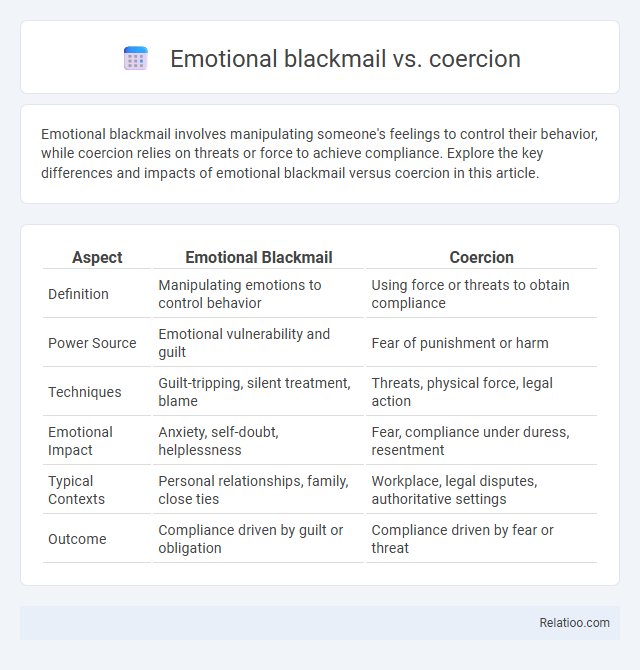Emotional blackmail involves manipulating someone's feelings to control their behavior, while coercion relies on threats or force to achieve compliance. Explore the key differences and impacts of emotional blackmail versus coercion in this article.
Table of Comparison
| Aspect | Emotional Blackmail | Coercion |
|---|---|---|
| Definition | Manipulating emotions to control behavior | Using force or threats to obtain compliance |
| Power Source | Emotional vulnerability and guilt | Fear of punishment or harm |
| Techniques | Guilt-tripping, silent treatment, blame | Threats, physical force, legal action |
| Emotional Impact | Anxiety, self-doubt, helplessness | Fear, compliance under duress, resentment |
| Typical Contexts | Personal relationships, family, close ties | Workplace, legal disputes, authoritative settings |
| Outcome | Compliance driven by guilt or obligation | Compliance driven by fear or threat |
Understanding Emotional Blackmail: Definition and Characteristics
Emotional blackmail involves manipulating someone's feelings by exploiting their fears, guilt, or sense of obligation to control their behavior, distinguishing it from coercion, which relies more on threats or force without necessarily invoking emotional vulnerabilities. Recognizing emotional blackmail requires identifying patterns where you are pressured through emotional triggers such as guilt trips, silent treatment, or exaggerated consequences to comply with the manipulator's demands. Your ability to set boundaries and assert your emotional autonomy is essential to resisting these tactics and protecting your mental well-being.
Defining Coercion: Meaning and Contexts
Coercion refers to the practice of persuading someone to do something by using force, threats, or intimidation, often undermining their free will. It commonly occurs in legal, interpersonal, and workplace contexts where power dynamics influence compliance. Understanding coercion helps you recognize when pressure crosses ethical boundaries, differentiating it from emotional blackmail which relies more on manipulating feelings rather than explicit threats.
Key Differences Between Emotional Blackmail and Coercion
Emotional blackmail involves manipulating someone's emotions, such as guilt or fear, to control their behavior, while coercion relies on threats or force to achieve compliance. Your ability to recognize emotional blackmail hinges on identifying subtle psychological pressure, whereas coercion is often explicit and involves tangible consequences. Understanding the key differences helps you set boundaries and respond effectively to manipulation tactics.
Psychological Tactics Used in Emotional Blackmail
Emotional blackmail employs psychological tactics such as guilt-tripping, fear induction, and obligation pressures to manipulate Your decisions, often blurring the lines between voluntary compliance and coercion. Unlike straightforward coercion, which relies on explicit threats or force, emotional blackmail subtly exploits Your vulnerabilities and emotional attachments to control behavior. Recognizing these manipulative strategies is crucial for maintaining healthy boundaries and psychological well-being.
Common Methods and Manifestations of Coercion
Coercion often involves threats, intimidation, or force to manipulate someone's choices, differing from emotional blackmail, which relies on guilt, fear, or obligation to control behavior. Common methods of coercion include verbal threats, physical intimidation, and restricting freedom to influence compliance. Understanding these manifestations helps you recognize when your autonomy is being undermined through manipulative tactics.
Impact on Victims: Emotional Blackmail vs. Coercion
Emotional blackmail manipulates victims through fear, guilt, and obligation, often leading to long-lasting emotional trauma and diminished self-worth. Coercion typically involves threats or force that create immediate compliance but can also result in anxiety, helplessness, and loss of autonomy over time. While both abuse forms damage mental health, emotional blackmail erodes trust and self-esteem more subtly, whereas coercion triggers acute stress responses linked to external pressure.
Warning Signs: How to Identify Emotional Blackmail and Coercion
Warning signs of emotional blackmail include guilt-tripping, excessive demands, and threats aimed at controlling your behavior through fear or obligation. Coercion often involves pressure, manipulation, and intimidation tactics to force compliance, frequently leaving you feeling powerless or trapped. Recognizing these patterns in relationships can help you protect your emotional boundaries and seek healthier interactions.
Legal Perspectives: Emotional Blackmail and Coercion
Emotional blackmail involves manipulation through fear, guilt, or obligation to control someone's behavior without explicit threats, while coercion legally requires the use or threat of force or unlawful pressure to compel action. In legal contexts, coercion is often recognized as a crime due to its direct impact on free will, whereas emotional blackmail may be harder to prove and typically falls under psychological abuse or manipulation in civil cases. Understanding these distinctions is crucial for protecting Your rights and identifying when legal intervention is necessary.
How to Respond to Emotional Blackmail or Coercion
Responding to emotional blackmail or coercion requires setting clear personal boundaries and recognizing manipulative tactics early to prevent further control. Maintain assertive communication by calmly stating your needs and consequences without guilt or defensiveness. Seeking external support from trusted individuals or professionals can provide validation and strategies to resist emotional manipulation effectively.
Seeking Help: Resources for Victims of Manipulation
Victims of emotional blackmail, coercion, and manipulation can find specialized help through organizations like the National Domestic Violence Hotline and resources such as therapy with licensed mental health professionals trained in trauma and abuse recovery. Support groups, both online and in-person, provide safe spaces for sharing experiences and strategies for empowerment and boundary-setting. Legal aid services and counseling centers also offer guidance on protective measures and personal safety planning tailored to the complexities of psychological abuse.

Infographic: Emotional blackmail vs Coercion
 relatioo.com
relatioo.com